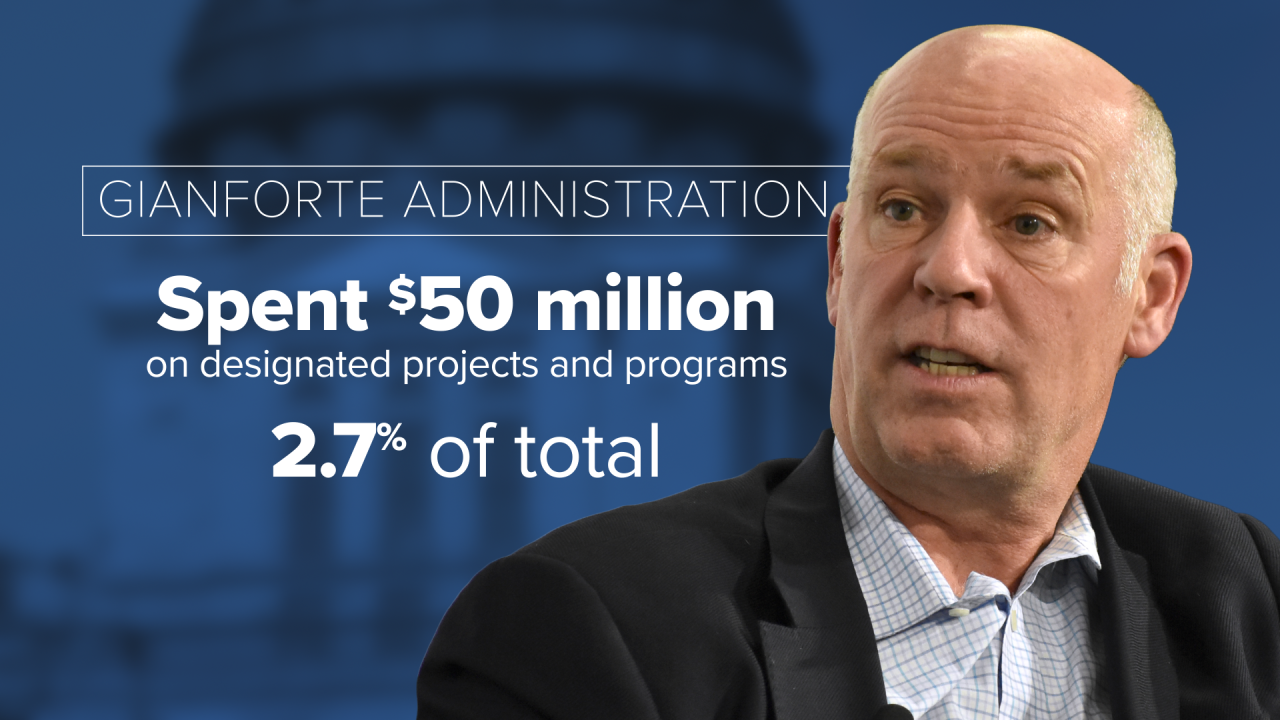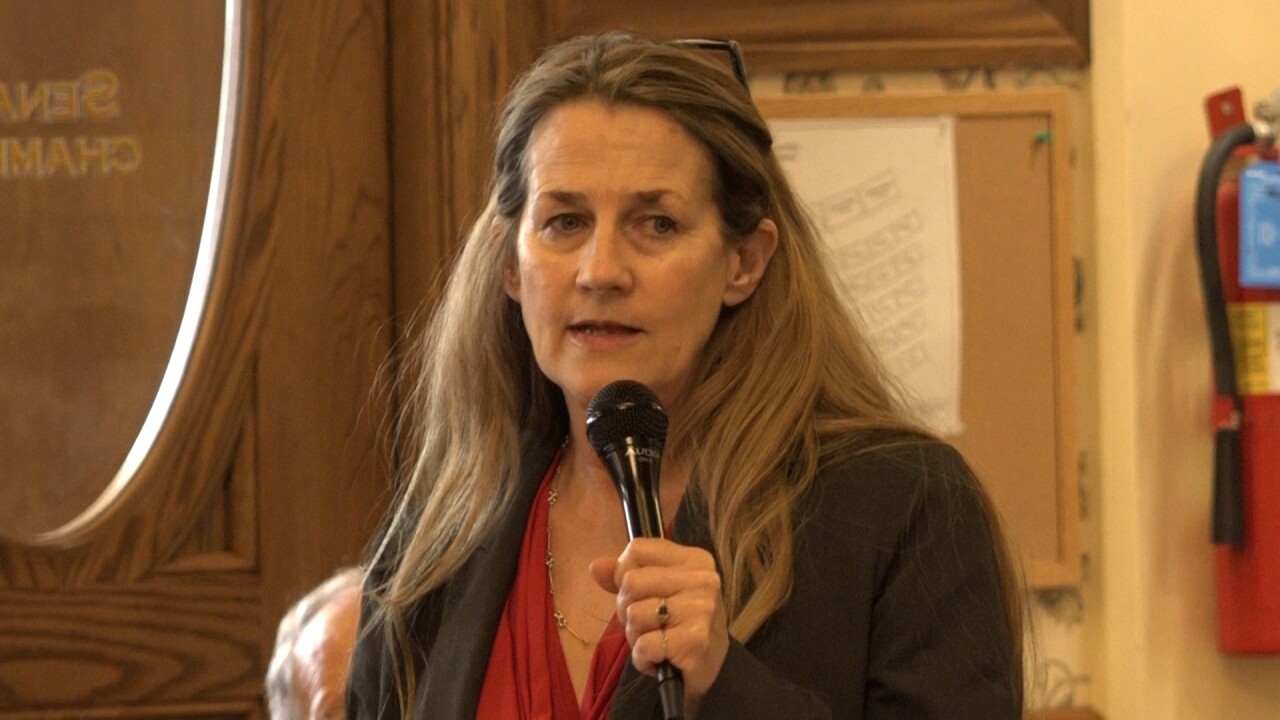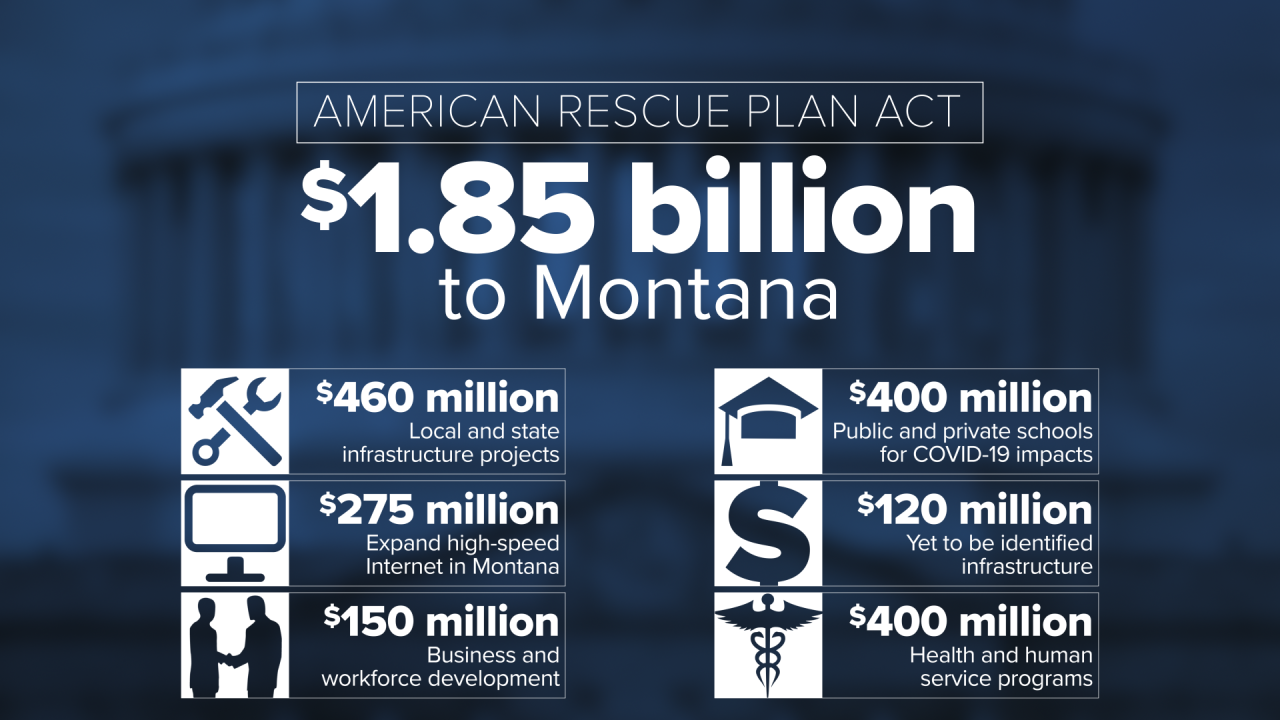HELENA — Seven months after Democrats in Congress approved nearly $2 billion in Covid-19 relief funds for Montana state officials to spend, less than 3 percent of the money has gone out the door.
But the Gianforte administration says much more is in the pipeline, and that it’s proceeding as quickly as it can – while also being deliberate in choosing to spend money addressing long-term problems laid bare by the pandemic.
“What we don’t want to do is just create a sugar-high of putting out money that creates a one-time bump or one-time assistance, but doesn’t help people really weather Covid and help people get back on their feet,” says Kurt Alme, the governor’s outgoing budget director.
Alme says Montana so far has received only about half the money from the feds -- $1.1 billion – and has approved where most of that money should go. The state also has “obligated,” or contracted about $230 billion on specific projects and programs, he says.
“I don’t blame people for wanting it to come out immediately, but we want to be very thoughtful and careful with how we proceed with all the ARPA funds, to make sure we’re taking care of all the details appropriately,” adds Mike Foster, who was state ARPA director through last week.
The state also has until 2024 to spend most of the money.
Still, the Gianforte administration so far has spent only about $50 million on designated projects and programs – only 2.7 percent of the nearly $2 billion under its control.

Critics say they’re not convinced the money is getting out as fast as it should – especially when it comes to programs directly affecting individuals and workers.
State Rep. Mary Caferro, a Helena Democrat who sits on the advisory commissions making recommendations for the human-service and health spending, notes that none of Montana’s American Rescue Plan Act (ARPA) money has been spent yet on child care, worker training, affordable housing or heating assistance.
Allocations for those programs total nearly $175 million. Caferro says that money was meant to help people who are struggling, now, and that the Gianforte administration has chosen to set up new, red-tape-laden processes to distribute these funds, when simply adding to existing programs would have worked faster.
“When this bill was passed (by Congress), it was intended to fix problems either exacerbated or brought on by the pandemic, to really help the people of Montana,” she says. “Montanans are struggling. And to frame that (help) as a `sugar-high’ is sticking your head in the sand. And that’s this administration’s approach.”

The Gianforte administration says it’s prepared to make $62 million of the $112 million in child-care funds available to providers “over the next several months,” and an online application process for $31 million of the money launches on Thursday.
Three other child-care assistance programs will be launched in November, December and January, it said.
The administration also told MTN News it is planning to use existing programs to distribute the $27 million in low-income household heating assistance, as well as creating a new program to help low-income households pay their water bills.
In an interview early this week, Caferro said that approach is what the state should be doing.

Here’s a quick look at the categories of spending, as approved by the 2021 Montana Legislature and the federal government, and the status of the available money:
- Infrastructure: Some $460 million is available for local and state infrastructure projects. Most of this money is going to local water-and-sewer projects.
The Gianforte administration approved grants for scores of projects late this summer and obligated $180 million of the funds, although none has technically been spent. Foster said the money is spent once local managers of the projects start paying contractors.
- Public and private schools: $400 million to deal with Covid-19 impacts. School districts across the state have been updating plans to spend this money – although they still have a fair amount of money left over from a previous round of federal aid approved in December.
Most school districts have submitted plans to the state Office of Public Instruction and two-thirds have had those plans and budgets approved, and can begin drawing down the federal money.
School officials say some of the types of spending supported by the money will be upgraded heating and air-circulation systems, additional personnel and addressing “learning loss” by students within the past year.
- High-speed Internet expansion: $275 million has been allocated to expand broadband infrastructure into unserved and under-served areas of Montana, but actual spending of the money isn’t expected to happen for some time.
The commission overseeing the money is working to map where the greatest needs are, before deciding how to set up a bidding and contracting process for the projects. It’s likely that broadband projects won’t begin until well into next year, at the earliest.
- Capital projects: $120 million for yet-to-be-identified infrastructure, that may include more high-speed Internet expansion. Alme said guidance for these projects just came out last week, for “bricks-and-mortar” projects that are supposed to encourage work and promote education and health screening.
- Business and workforce development: $150 million. Included in this category is workforce training, affordable housing financing and grants for “business innovation” and “value-added agriculture.”
The only part of this money that’s been spent is $1.5 million for return-to-work bonuses, which were offered by the Gianforte administration when it cut off expanded federal unemployment payments for Montanans – or 10 percent of the amount allocated for the program.
Alme said workforce training and affordable-housing programs are almost ready to go, and that the commission and the administration are just starting to work on the business-innovation and ag grants.
- Health and human-service programs: Almost $400 million is available here, most of which was categorized by the federal government – although it’s up to the Gianforte administration to design and implement how it spends the money.
The biggest chunks of this money are testing, contact tracing and vaccines for Covid-19 ($165 million), child care ($112 million) and low-income heating and water-bill assistance ($32 million).
It also includes funds for Food Stamps, enhancing the public-health workforce, mental health services, child-abuse prevention and nursing-home beds.
Foster said state and local agencies still have some unspent federal funds for Covid-19 testing and vaccines, and will start spending the ARPA funds when the prior money runs out.
Alme says Montana expects to get the second half of its $2 billion next spring, although federal officials say the state can still start the planning process for spending it. About 20 states with higher unemployment rates got their entire allocation upfront.
The state also is distributing $86 million to towns and cities with less than 50,000 population and has sent out half of that money. The rest will be available when the state gets its second half of the overall money.
Three cities – Billings, Missoula and Great Falls – got their share of ARPA funds directly from the federal government under the ARPA bill.
Last year, Republicans repeatedly criticized Democratic Gov. Steve Bullock for not spending federal Covid-19 relief funds quickly enough, under the CARES Act that was approved in March. The Bullock administration ultimately spent most of the $1.25 billion allocated to the state by the end of the year.
When asked why Republicans aren’t applying the same standard to the Gianforte administration, Alme said ARPA and the CARES Act are two very different programs, with different parameters and goals.
The CARES Act was meant to get money into people’s hands quickly, to help them get through widespread shutdowns during the start of the pandemic, he says.
“ARPA is more of a long-term recovery focus,” Alme told MTN News. “And that’s certainly the way the Legislature and the advisory commissions and the governor are focused.”



